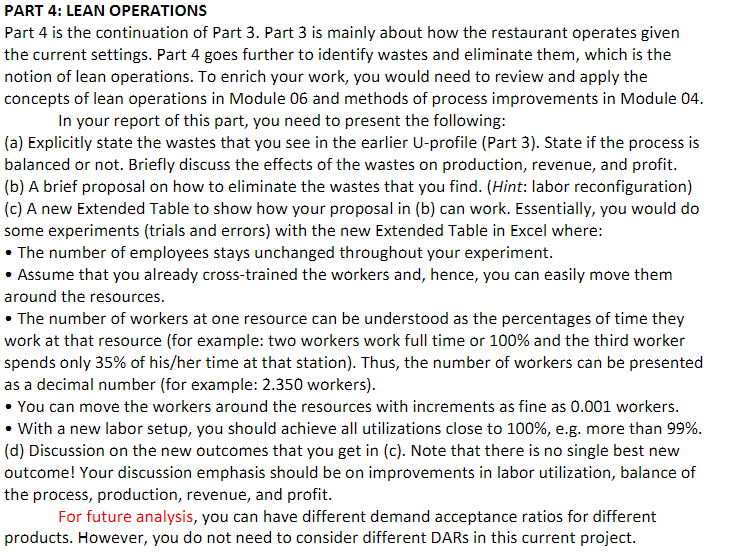Answered step by step
Verified Expert Solution
Question
1 Approved Answer
Please use the following information from part 3: Station/Resource R1 R2 R3 R4 R5 R6 Number of workers 5 3 3 2 3 4 Processing

Please use the following information from part 3:
| Station/Resource | R1 | R2 | R3 | R4 | R5 | R6 | |
| Number of workers | 5 | 3 | 3 | 2 | 3 | 4 | |
| Processing time for A (minutes/unit/worker) | 2.5 | 2 | 1.5 | 0 | 1 | 0 | |
| Processing time for B (minutes/unit/worker) | 0.5 | 1 | 2 | 1.5 | 0 | 1.5 | |
| Processing time for C (minutes/unit/worker) | 2 | 1.5 | 0 | 0 | 2.5 | 1 | |
| Capacity | |||||||
| Capacity (minutes/hour) | 300 | 180 | 180 | 120 | 180 | 240 | |
| Capacity (minutes/day) (10 hours/day) | 3000 | 1800 | 1800 | 1200 | 1800 | 2400 | |
| Demand, Workload, & Implied Utilization | |||||||
| Demand for A (units/day) | 540 | 540 | 540 | 0 | 540 | 0 | |
| Demand for B (units/day) | 576 | 576 | 576 | 576 | 0 | 576 | |
| Demand for C (units/day) | 696 | 696 | 0 | 0 | 696 | 696 | |
| Workload on A (minutes/day) | 1350 | 1080 | 810 | 0 | 540 | 0 | |
| Workload on B (minutes/day) | 288 | 576 | 1152 | 864 | 0 | 864 | |
| Workload on C (minutes/day) | 1392 | 1044 | 0 | 0 | 1740 | 696 | |
| Total workload (minutes/day) | 3030 | 2700 | 1962 | 864 | 2280 | 1560 | Demand Acceptance Ratio |
| Implied utilization (%, 2 decimals) | 101% | 150% | 109% | 72% | 127% | 65% | 67% |
| Flow Rate & Utilization | |||||||
| Flow rate of A (units/day) | 360 | 360 | 360 | 0 | 360 | 0 | |
| Flow rate of B (units/day) | 384 | 384 | 384 | 384 | 0 | 384 | |
| Flow rate of C (units/day) | 464 | 464 | 0 | 0 | 464 | 464 | |
| Effective workload on A (minutes/day) | 900 | 720 | 540 | 0 | 360 | 0 | |
| Effective workload on B (minutes/day) | 192 | 384 | 768 | 576 | 0 | 576 | |
| Effective workload on C (minutes/day) | 928 | 696 | 0 | 0 | 1160 | 464 | |
| Total effective workload (minutes/day) | 2020 | 1800 | 1308 | 576 | 1520 | 1040 | |
| Effective IU (%, 2 decimals) | 67% | 100% | 73% | 48% | 84% | 43% | |
| Utilization (%, 2 decimals) | 67% | 100% | 73% | 48% | 84% | 43% |
Step by Step Solution
There are 3 Steps involved in it
Step: 1

Get Instant Access to Expert-Tailored Solutions
See step-by-step solutions with expert insights and AI powered tools for academic success
Step: 2

Step: 3

Ace Your Homework with AI
Get the answers you need in no time with our AI-driven, step-by-step assistance
Get Started


